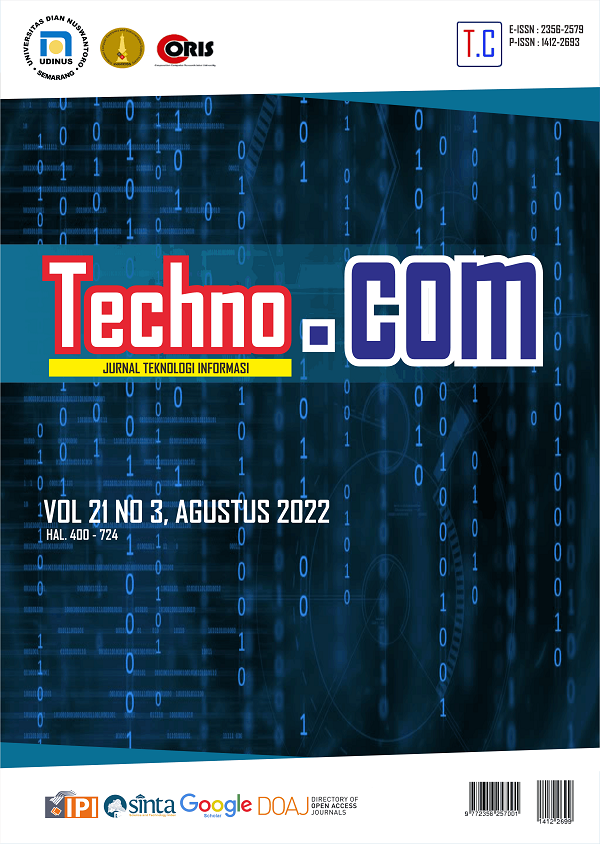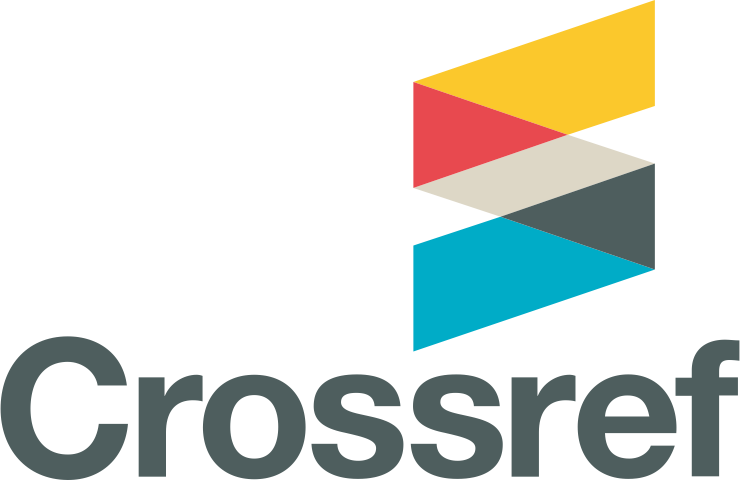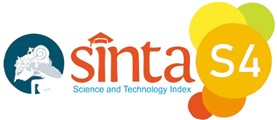Perbandingan AlexNet dan VGG untuk Pengenalan Ekspresi Wajah pada Dataset Kelas Komputasi Lanjut
DOI:
https://doi.org/10.33633/tc.v21i3.6373Keywords:
Adam, Confusion Matrix, Pelatihan Fitur, Sensitivitas, Tingkat Positif BenarAbstract
Pengenalan emosi memainkan peran penting dalam komunikasi yang dapat dikenali dari ekspresi wajah. Terdapat banyak metode yang dapat digunakan untuk mengenali ekspresi wajah secara automatis, seperti convolutional neural network (CNN). Penelitian ini bertujuan untuk mengimplementasikan dan membandingkan model CNN dengan arsitektur AlexNet dan VGG untuk pengenalan ekspresi wajah menggunakan bahasa pemrograman Julia. Model CNN akan digunakan untuk mengklasifikasikan tiga ekspresi yang berbeda dari tujuh orang pengekspresi. Data diproses dengan beberapa teknik augmentasi data untuk mengatasi masalah keterbatasan data. Hasil penelitian menunjukkan bahwa ketiga arsitektur dapat mengklasifikasikan ekspresi wajah dengan sangat baik, yang ditunjukkan oleh nilai rata-rata akurasi pada data training dan testing yang lebih dari 94%. Untuk memenuhi nilai cross-entropy sebesar 0.1, arsitektur VGG-11 memerlukan jumlah epoch yang paling sedikit dibandingkan arsitektur lainnya, sedangkan arsitektur AlexNet memerlukan waktu komputasi yang paling sedikit. Waktu komputasi pada proses pelatihan sebanding dengan jumlah parameter yang terkandung pada model CNN. Akan tetapi, jumlah epoch yang sedikit belum tentu membutuhkan waktu komputasi yang sedikit. Selain itu, nilai recall, presisi, dan F1-score untuk masalah klasifikasi multi-class menunjukkan hasil yang baik, yaitu lebih dari 94%.References
B. Niu, Z. Gao, and B. Guo, “Facial Expression Recognition with LBP and ORB Features,” Comput. Intell. Neurosci., 2021, doi: 10.1155/2021/8828245.
A. Mehrabian, “Communication without words,” in Communication Theory: Second Edition, 2nd ed., D. Mortensen, Ed. New York: Routledge, 2017, pp. 193–200. doi: 10.4324/9781315080918-15.
F. Dornaika and B. Raducanu, “Efficient facial expression recognition for human robot interaction,” in Lecture Notes in Computer Science (including subseries Lecture Notes in Artificial Intelligence and Lecture Notes in Bioinformatics), 2007, vol. 4507 LNCS, pp. 700–708. doi: 10.1007/978-3-540-73007-1_84.
S. Hickson, V. Kwatra, N. Dufour, A. Sud, and I. Essa, “Eyemotion: Classifying facial expressions in VR using eye-tracking cameras,” in Proceedings - 2019 IEEE Winter Conference on Applications of Computer Vision (WACV), 2019, pp. 1626–1635. doi: 10.1109/WACV.2019.00178.
C. H. Chen, I. J. Lee, and L. Y. Lin, “Augmented reality-based self-facial modeling to promote the emotional expression and social skills of adolescents with autism spectrum disorders,” Res. Dev. Disabil., vol. 36, pp. 396–403, 2015, doi: 10.1016/j.ridd.2014.10.015.
M. A. Assari and M. Rahmati, “Driver drowsiness detection using face expression recognition,” in 2011 IEEE International Conference on Signal and Image Processing Applications (ICSIPA), 2011, pp. 337–341. doi: 10.1109/ICSIPA.2011.6144162.
A. Mahmood, S. Hussain, K. Iqbal, and W. S. Elkilani, “Recognition of Facial Expressions under Varying Conditions Using Dual-Feature Fusion,” Math. Probl. Eng., vol. 2019, 2019, doi: 10.1155/2019/9185481.
N. S. Altman, “An introduction to kernel and nearest-neighbor nonparametric regression,” Am. Stat., vol. 46, no. 3, pp. 175–185, 1992, doi: 10.1080/00031305.1992.10475879.
I. Kotsia and I. Pitas, “Facial expression recognition in image sequences using geometric deformation features and support vector machines,” IEEE Trans. Image Process., vol. 16, no. 1, pp. 172–187, 2007, doi: 10.1109/TIP.2006.884954.
J. R. Lee, L. Wang, and A. Wong, “EmotionNet Nano: An Efficient Deep Convolutional Neural Network Design for Real-Time Facial Expression Recognition,” Front. Artif. Intell., vol. 3, pp. 1–9, 2021, doi: 10.3389/frai.2020.609673.
S. Li and W. Deng, “Deep facial expression recognition: a survey,” J. Image Graph., vol. 25, no. 11, pp. 2306–2320, 2020, doi: 10.11834/jig.200233.
W. Mellouk and W. Handouzi, “Facial emotion recognition using deep learning: Review and insights,” Procedia Comput. Sci., vol. 175, pp. 689–694, 2020, doi: 10.1016/j.procs.2020.07.101.
Y. LeCun, L. Bottou, Y. Bengio, and P. Haffner, “Gradient-based learning applied to document recognition,” in Proceedings of the IEEE, 1998, vol. 86, no. 11, pp. 2278–2323. doi: 10.1109/5.726791.
M. Z. Alom et al., “A state-of-the-art survey on deep learning theory and architectures,” Electron., vol. 8, no. 3, 2019, doi: 10.3390/electronics8030292.
Y. Sun, B. Xue, M. Zhang, and G. G. Yen, “Evolving Deep Convolutional Neural Networks for Image Classification,” IEEE Trans. Evol. Comput., vol. 24, no. 2, pp. 394–407, 2020, doi: 10.1109/TEVC.2019.2916183.
E. Aydemir and K. Karagul, “Solving a Periodic Capacitated Vehicle Routing Problem Using Simulated Annealing Algorithm for a Manufacturing Company,” Brazilian J. Oper. Prod. Manag., vol. 17, no. 1, 2020, doi: 10.14488/bjopm.2020.011.
R. Sells, “Julia Programming Language Benchmark Using a Flight Simulation,” IEEE Aerosp. Conf. Proc., 2020, doi: 10.1109/AERO47225.2020.9172277.
C. Shorten and T. M. Khoshgoftaar, “A survey on Image Data Augmentation for Deep Learning,” J. Big Data, vol. 6, no. 1, 2019, doi: 10.1186/s40537-019-0197-0.
Z. Emersic, D. Stepec, V. Struc, and P. Peer, “Training Convolutional Neural Networks with Limited Training Data for Ear Recognition in the Wild,” in Proceedings - 12th IEEE International Conference on Automatic Face and Gesture Recognition, FG 2017 - 1st International Workshop on Adaptive Shot Learning for Gesture Understanding and Production, ASL4GUP 2017, Biometrics in the Wild, Bwild 2017, Heteroge, 2017, pp. 987–994. doi: 10.1109/FG.2017.123.
J. Gu et al., “Recent Advances in Convolutional Neural Networks,” Pattern Recognit., vol. 77, pp. 354–377, 2018, doi: 10.1016/j.patcog.2017.10.013.
J. Duchi, E. Hazan, and Y. Singer, “Adaptive subgradient methods for online learning and stochastic optimization,” COLT 2010 - 23rd Conf. Learn. Theory, vol. 12, pp. 257–269, 2010.
T. Tieleman and G. E. Hinton, “Coursera: Neural networks for machine learning,” 2012.
D. P. Kingma and J. L. Ba, “Adam: A method for stochastic optimization,” in 3rd International Conference on Learning Representations (ICLR), 2015, pp. 1–15.
I. Markoulidakis, G. Kopsiaftis, I. Rallis, and I. Georgoulas, “Multi-Class Confusion Matrix Reduction method and its application on Net Promoter Score classification problem,” ACM Int. Conf. Proceeding Ser., vol. 9, no. 4, pp. 412–419, 2021, doi: 10.1145/3453892.3461323.
Downloads
Published
Issue
Section
License
Copyright (c) 2022 Sri Nurdiati

This work is licensed under a Creative Commons Attribution-NonCommercial 4.0 International License.
License Terms
All articles published in Techno.COM Journal are licensed under the Creative Commons Attribution-NonCommercial 4.0 International (CC BY-NC 4.0). This means:
1. Attribution
Readers and users are free to:
-
Share – Copy and redistribute the material in any medium or format.
-
Adapt – Remix, transform, and build upon the material.
As long as proper credit is given to the original work by citing the author(s) and the journal.
2. Non-Commercial Use
-
The material cannot be used for commercial purposes.
-
Commercial use includes selling the content, using it in commercial advertising, or integrating it into products/services for profit.
3. Rights of Authors
-
Authors retain copyright and grant Techno.COM Journal the right to publish the article.
-
Authors can distribute their work (e.g., in institutional repositories or personal websites) with proper acknowledgment of the journal.
4. No Additional Restrictions
-
The journal cannot apply legal terms or technological measures that restrict others from using the material in ways allowed by the license.
5. Disclaimer
-
The journal is not responsible for how the published content is used by third parties.
-
The opinions expressed in the articles are solely those of the authors.
For more details, visit the Creative Commons License Page:
? https://creativecommons.org/licenses/by-nc/4.0/












